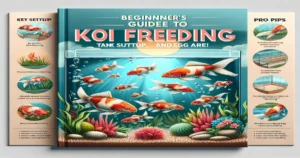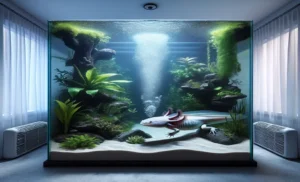Introduction
Are you tired of the usual goldfish and guppies? Exploring unique home aquarium animals can be incredibly rewarding. Not only do these creatures add variety and intrigue to your tank, but they also offer fascinating behaviors and striking appearances that captivate both novice and experienced aquarists alike. In this blog post, we’ll introduce you to nine unique aquarium animals that can thrive in your home setup. We’ll also discuss the benefits of opting for these unusual species over traditional choices and give you a brief overview of the different types of aquarium environments—freshwater, brackish, and saltwater—that you can create.

Freshwater Aquarium Animals
Pea Puffer
The Pea Puffer, also known as the Dwarf Pufferfish, is a tiny but vibrant addition to any freshwater aquarium. Originating from the rivers of Southwest India, these little fish pack a lot of personality into their small size. They are known for their curious and active nature.
Owning a Pea Puffer comes with several advantages. Their small size (up to 1.4 inches) makes them suitable for smaller tanks, and their lively behavior can be entertaining to watch. Despite their size, Pea Puffers are predators, so they can help control small pest populations in your tank.
When it comes to care, Pea Puffers require a well-planted tank with plenty of hiding spots, as they are territorial. They thrive on a varied diet that includes live or frozen foods like bloodworms and snails. Regular water changes are crucial to keep the environment clean and healthy for these tiny fish.
Freshwater Stingray
Freshwater Stingrays are a truly unique and mesmerizing addition to any aquarium, known for their elegant movements and distinctive body shape. Unlike their saltwater cousins, freshwater stingrays are found in river basins in South America.
One of the standout features of freshwater stingrays is their flattened bodies and long, whip-like tails. They are highly interactive and can even recognize their owners, making them fascinating pets. However, keeping them requires a significant commitment due to their specific needs.
Maintaining freshwater stingrays can be challenging. They need a large tank with a soft, sandy substrate to prevent injury to their delicate undersides. Proper filtration and regular water changes are essential to maintain pristine water conditions. Additionally, their diet should include a mix of live and frozen foods like shrimp and worms to ensure they receive the necessary nutrition.
Ghost Shrimp
Ghost Shrimp, also known as Glass Shrimp, are a popular choice for aquarists looking to add some diversity to their freshwater tanks. These tiny, translucent creatures are native to North America and are known for their scavenging abilities.
One of the biggest advantages of owning ghost shrimp is their role as tank cleaners. They consume leftover food, algae, and detritus, helping to keep the tank clean. Additionally, they are cost-effective and can be purchased in large quantities to establish a thriving colony.
Caring for ghost shrimp is relatively straightforward. They thrive in tanks with plenty of hiding spots, such as plants and driftwood. Their diet consists of algae, detritus, and commercial shrimp pellets. Regular water changes and maintaining stable water parameters are essential to ensure their well-being.

Brackish Aquarium Animals
Mudskippers
Mudskippers are one of the most unique brackish water species you can add to your aquarium. These fish are known for their ability to live both in water and on land, thanks to their specialized pectoral fins and gill chambers.
One of the most fascinating traits of mudskippers is their ability to “walk” on land using their pectoral fins. They are highly active and playful, often engaging in territorial displays and surface interactions. Having mudskippers in your tank can provide endless entertainment.
Creating an ideal habitat for mudskippers involves setting up a brackish aquarium with a sandy substrate and plenty of climbing structures like rocks and driftwood. They require a mix of fresh and saltwater to replicate their natural environment. Additionally, their diet should include a variety of live and frozen foods, such as insects, worms, and small crustaceans.
Fahaka Puffer
The Fahaka Puffer, also known as the Nile Puffer, is a striking brackish water species known for its vibrant colors and powerful jaw. Originating from the freshwater and brackish waters of Africa, these puffers are highly sought after by experienced aquarists.
One of the standout features of the Fahaka Puffer is its ability to inflate itself as a defense mechanism. Their bold personalities and vibrant colors make them a captivating addition to any tank. However, they require specific care and attention due to their aggressive nature.
Caring for a Fahaka Puffer involves providing a spacious tank with plenty of hiding spots and ample swimming space. They have strong teeth that continuously grow, so their diet should include hard-shelled foods like snails and crustaceans to help wear down their teeth. Regular water changes and maintaining stable water parameters are essential to ensure their health.
Archerfish
Archerfish are known for their unique hunting abilities, making them a fascinating addition to any brackish aquarium. These fish are native to Southeast Asia and Australia and are renowned for their ability to shoot jets of water to knock insects off plants and into the water.
One of the most intriguing behaviors of archerfish is their precision in shooting down prey. Watching them hunt can be a mesmerizing experience. Additionally, they are generally peaceful and can coexist with other compatible species.
Creating an ideal habitat for archerfish involves setting up a brackish aquarium with plenty of overhanging branches or floating plants to replicate their natural hunting environment. Their diet should include a mix of live and frozen foods like insects, small fish, and shrimp. Maintaining stable water parameters and providing ample space for swimming are crucial for their well-being.

Saltwater Aquarium Animals
Octopus
Octopuses are among the most intelligent and fascinating creatures you can keep in a saltwater aquarium. Their problem-solving abilities, camouflage skills, and unique behaviors make them a captivating addition to any marine setup.
One of the most remarkable aspects of octopuses is their intelligence. They can solve puzzles, escape from enclosures, and even recognize individual humans. Keeping an octopus can provide endless opportunities for observation and interaction. However, they require specialized care and attention.
Maintaining an octopus involves providing a secure tank with plenty of hiding spots and enrichment items to keep them mentally stimulated. Their diet should include a variety of live and frozen foods like crabs, shrimp, and small fish. Additionally, regular water changes and maintaining stable water parameters are essential to ensure their health.
Seahorse
Seahorses are known for their delicate beauty and unique appearance, making them a popular choice for saltwater aquariums. These captivating creatures are found in shallow coastal waters around the world and are renowned for their unique reproductive behavior.
One of the most enchanting qualities of seahorses is their appearance, with their horse-like heads and prehensile tails. They are also known for their slow and graceful movements. Keeping seahorses can provide a sense of tranquility and wonder in your aquarium.
Caring for seahorses requires providing a tank with plenty of vertical structures like live rock and plants for them to anchor onto. Their diet should include small live foods like brine shrimp and copepods. Maintaining stable water parameters and a low-stress environment is crucial to their well-being.
Jellyfish
Jellyfish are mesmerizing creatures that can add a touch of elegance and tranquility to your saltwater aquarium. With their translucent bodies and graceful movements, they create a captivating visual display.
One of the most enchanting qualities of jellyfish is their appearance, with their pulsating bell and trailing tentacles. Watching them move through the water can be a calming and meditative experience. However, keeping jellyfish requires specialized care and equipment.
Maintaining jellyfish involves providing a specialized tank with gentle water flow to prevent them from getting trapped or damaged. Their diet should include small live foods like brine shrimp and plankton. Additionally, regular water changes and maintaining stable water parameters are essential to ensure their health.
Conclusion
Exploring unique home aquarium animals can be a rewarding and enriching experience for any aquarist. From the lively Pea Puffer to the mesmerizing Jellyfish, each species offers its own set of challenges and rewards. Before adding any unconventional species to your tank, it’s essential to conduct thorough research and ensure you can meet their specific care requirements. By doing so, you’ll not only enhance the beauty and diversity of your aquarium but also contribute to the well-being of these fascinating creatures. Happy fishkeeping!



